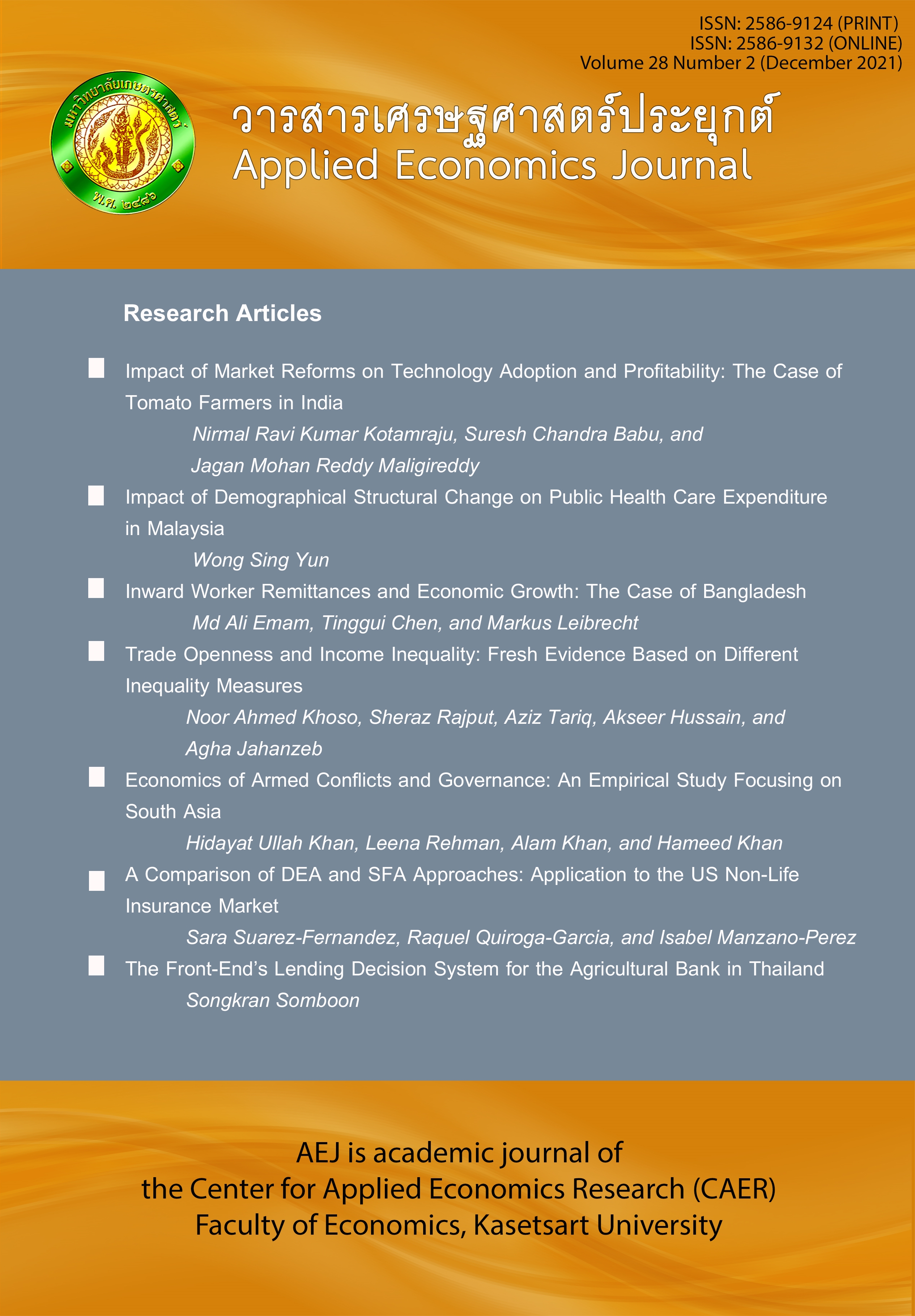The Front-End’s Lending Decision System for the Agricultural Bank in Thailand
Main Article Content
Abstract
The main objective of this study is to develop the front-end’s lending decision system of the Bank for Agriculture and Agricultural Cooperatives, a major lender in Thailand’s agricultural sector. The logit model and the artificial neural network model have been developed to reflect risk factors to identify the probability of default by each new borrower. The study supports the use of the logit model to develop the system because it gives more accuracy in predicting the probability of default and debtor classification than the artificial neural network model. The working process of the system is classified into two sections including credit risk management, which is the process of screening the loan applications and setting the credit approval or rejection criteria, and affordability risk management, which is the process of determining the maximum loan amount for the debtor who has passed the credit approval criteria. In this study, the author caps the debt service ratio as a threshold for determining the amount of credit (the loan amount approved and interest expense) at 70% and determines that the maximum loan principal is 63% of the debtor's total annual income. The system is also used as an instrument to support the implementation of appropriate credit policies in handling agricultural households’ excess debt and promote the building of financial discipline for agricultural households in the rural sector of Thailand.
Article Details
The paper is published under CC BY-NC-ND, in which the article is freely downloaded and shared in its original form non-commercially and its citation details are identified.
References
Altman, E. I., Glancario, M., & Varetto, F. (1994). Corporate distress diagnosis: Comparisons using linear discriminant analysis and neural networks (The Italian experience). Journal of Banking and Finance, 18(3), 505-529.
Bandyopadhyay, A. (2007). Credit risk models for managing bank’s agricultural loan portfolio. ICFAI Journal of Financial Risk Management, 5(4), 86-102.
Barney, D. K., Graves, O. F., & Johnson, J. D. (1999). The farmers home administration and farm debt failure prediction. Journal of Accounting and Public Policy, 18(2), 99-139.
Bank of Thailand. (2005). Circulated letter No.: ThorPorTor. SorGorSor. (03) Wor. 227/2548 Re: Guidelines for Risk Management Practices. Retrieved from https://www.bot.or.th/Thai/FIPCS/Documents/FPG/2548/EngPDF/25480006.pdf
Bank of Thailand. (2019). Policy guidelines for appropriate retail credit to take care of the problem of excessive debt of the household sector. Retrieved from https://www.bot.or.th/Thai/FinancialInstitutions/Publications/Pages/ConsultationPaperLoan.aspx
Chen, W. S., & Du, Y. K. (2009). Using neural networks and data mining techniques for the financial distress prediction model. Expert Systems with Applications, 36(2), 4075-4086.
Coakley, J. R., & Brown, C. E. (2000). Artificial neural networks in accounting and finance: modeling issues. International Journal of Intelligent Systems in Accounting, Finance & Management, 9, 119-144.
Hu, Y. (2008). Incorporating a non-additive decision making method into multi-layer neural networks and its application to financial distress analysis. Knowledge-Based Systems, 21(5), 383-390.
Lee, T. H., & Jung, S. C. (2000). Forecasting creditworthiness: Logistic vs. artificial neural network. The Journal of Business Forecasting Methods and Systems, 18(4), 28-30.
Limsombunchai, V., Christopher, G., & Minsoo, L. (2005). An analysis of credit scoring for agricultural loans in Thailand. American Journal of Applied Sciences, 2(8), 1198-1205.
Somboon, S. (2015a). Credit risk portfolio management system for agricultural lending of the rural financial market in Thailand. Thammasat Economic Journal, 33(1), 76-122.
Somboon, S. (2015b). Credit scoring system for managing risk in agricultural loan portfolio of the Thai rural financial market. Applied Economics Journal, 22(1), 27-50.
Somboon, S. (2017). Credit risk management system for managing risk in farmer loan portfolio of the agricultural financial institution in Thailand. NIDA Development Journal, 57(3), 100-130. (in Thai)
Turvey, C. G. (1991). Credit scoring for agricultural loans: A review with application. Agricultural Finance Review, 51, 43-54.
Turvey, C. G., & Brown, R. (1990). Credit scoring for a federal lending institution: The case of Canada’s farm credit corporation. Agricultural Finance Review, 50, 47-57.
Turvey, C. G., & Weersink, A. (1997). Credit risk and the demand for agricultural loans. Canadian Journal of Agricultural Economics, 45(3), 201-217.
Wu, C. & Wang, X.M. (2000). A neural network approach for analyzing small business lending decision. Review of Quantitative Finance and Accounting, 15, 259-276.


